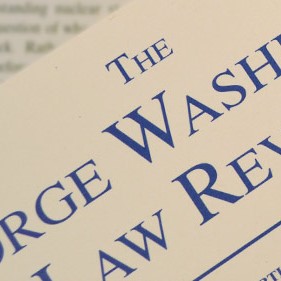Gregory P. Magarian · June 2008
76 GEO. WASH. L. REV. 845 (2008)
From the dawn of broadcasting until the late 1980s, the federal government vigorously employed substantive media regulations—legal guidelines about the substance of programming—to try to ensure that the broadcast industry would serve the public interest. The most familiar element of substantive broadcast regulation, and the phrase that has become shorthand for the entire effort, was the Federal Communications
Commission’s (“FCC”) fairness doctrine. That doctrine required television and radio broadcasters, first, to devote a reasonable percentage of airtime to covering issues of public importance and, second, to provide a reasonable opportunity for the expression of opposing views on those issues. Substantive broadcast regulation also included FCC requirements that broadcasters offer reply time to any entity whose “honesty, character, [or] integrity” came under attack on the air in connection with a controversial issue of public importance and to any political candidate whose opponent a broadcast editorial endorsed. In addition, Congress required broadcasters to give political candidates reasonable opportunities for purchasing air time and to extend opposing candidates the same access to free or purchased time. The Supreme Court upheld the candidate access rules against a First Amendment challenge, and they remain in effect. The FCC, however, has scrapped the fairness doctrine and the personal attack and political editorial rules, despite the Court’s rejection of a First Amendment challenge to those regulations in Red Lion Broadcasting Co. v. FCC.
The FCC’s abandonment of the fairness doctrine resulted from a confluence of currents in law and public policy. Legislators and regulators in the late-Cold War period became fixated on the idea that the economic marketplace could solve every problem without interference from the heavy hand of government. Meanwhile, the Supreme Court—just five years after, and in sharp contrast to, its Red Lion decision—struck down a personal attack reply requirement for newspapers in Miami Herald Publishing Co. v. Tornillo. The Court’s turn against substantive media regulation reflects a free speech orthodoxy that crystallized in the 1970s and still prevails today, under which the First Amendment simply protects whatever distribution of expressive opportunities the economic market happens to produce. That orthodoxy renders incoherent—even improper—any suggestion that constitutional expressive freedom should serve some instrumental conception of just distribution or effective public debate. As regulators and the Court have subordinated public policy and constitutional doctrine to the market, substantive media regulation has largely receded into antiquity. Few voices in the past two decades have spoken well of the fairness doctrine.
A few commentators, however, have continued to defend the idea of substantive media regulation against the dominant legal and political currents. Jerome Barron has led the effort. In Barron’s conception, the First Amendment is not a lock that safeguards the market-derived expressive prerogatives of powerful media corporations. Rather, the Amendment’s guarantees of free speech and a free press form a key, designed to open public debate to the diverse range of participants and ideas necessary for our democratic system to flourish. Barron’s pioneering writings on First Amendment access rights mark the pinnacle of this First Amendment vision. In the ensuing decades, while engaging nuance and eschewing partisanship, Barron has continued to chart pathways toward enhanced media access, and he has relentlessly critiqued the Court’s and regulators’ retreat from the Red Lion decision’s tentative steps toward access rights. From the beginning, Barron understood the limits of the fairness doctrine better than most libertarian critics, stressing the clumsiness of administrative enforcement and the need to root access principles not merely in political discretion but also in a positive constitutional vision. Nonetheless, he has consistently defended those regulations as useful paving stones on the road to fulsome access rights, while also offering incisive proposals to refine substantive media regulation.
This Article attempts to transcend the partisan divide and engage the debate over substantive media regulation in a manner that honors Barron’s thoughtful example. It seeks to impose order on, and develop some insights from, arguments for and against substantive media regulation that allow for some government role in making the mass media more broadly accessible and more informative about matters of public concern. Elsewhere, I have critiqued the libertarian position that the First Amendment absolutely bars any judicial or regulatory effort to broaden media access. Accordingly, I set that position aside here, and with it much conventional First Amendment doctrine. Instead I consider arguments that, without necessarily foreclosing the theoretical basis of Barron’s case for access rights, nonetheless oppose substantive media regulation as some combination of practically unworkable; undesirable when compared with policy alternatives such as subsidy programs and structural regulations of media ownership; and distinctively, intractably offensive even to a conception of the First Amendment that permits some form of access initiative. These objections depend on descriptive accounts of substantive media regulations and their consequences that differ fundamentally from the accounts offered by the regulations’ supporters.

